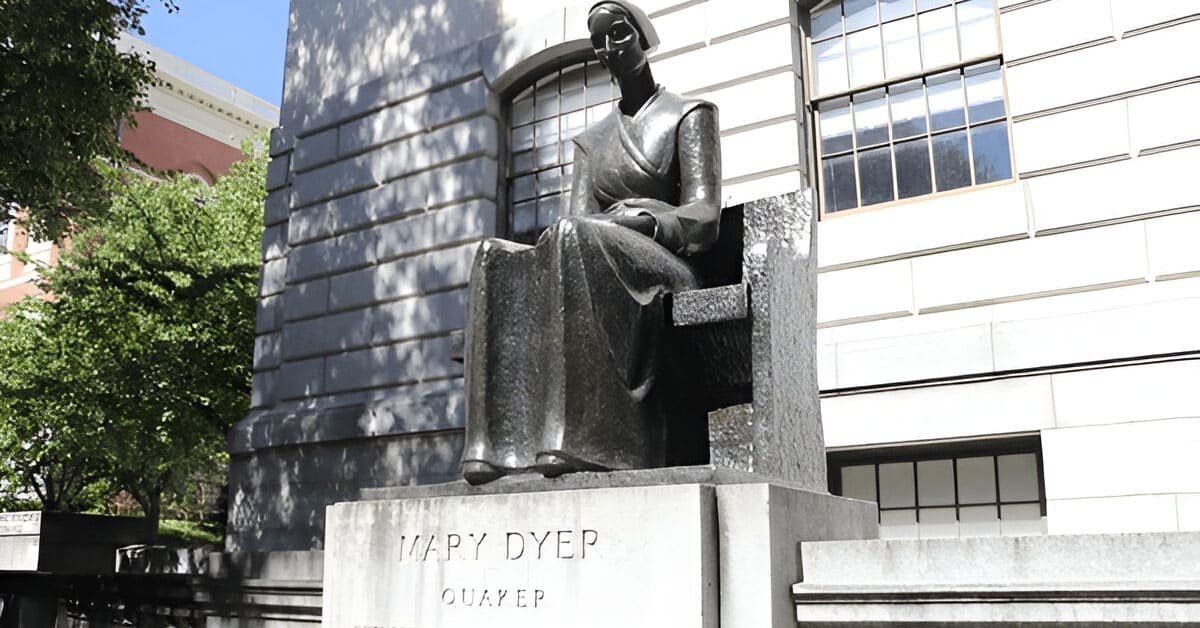Physical Address
304 North Cardinal St.
Dorchester Center, MA 02124
Physical Address
304 North Cardinal St.
Dorchester Center, MA 02124

The Mary Dyer Statue in Boston is not just a striking bronze figure but a powerful symbol of religious freedom, tolerance, and the sacrifices made to pursue justice. Located in one of Boston’s most historic and politically charged areas, this statue invites visitors to reflect on the enduring legacy of an extraordinary woman who stood unwaveringly for her beliefs. Whether you’re a history buff, a lover of public art, or simply seeking to connect with Boston’s rich tapestry of stories, the Mary Dyer Statue offers a meaningful stop on your journey through the city.
The Mary Dyer Statue stands prominently on the grounds of the Massachusetts State House, located on Beacon Hill in Boston, Massachusetts. It is situated at the corner of Beacon Street and Bowdoin Street, just a stone’s throw from the Boston Common. Perched on a granite pedestal, the statue is part of a landscape steeped in historic significance.
Mary Dyer was a Quaker and an outspoken advocate for religious freedom during the 17th century when dissenting from Puritan orthodoxy was met with harsh punishment in the Massachusetts Bay Colony. Born in England in 1611, Dyer emigrated to New England with her husband and became an early follower of the Quaker faith, which valued individual conscience and equality. This put her at odds with the rigid Puritan establishment, which sought to suppress dissent.
Her faith led her to defy Puritan authorities repeatedly. She was arrested and banished from the colony multiple times but returned each time to advocate for Quaker beliefs. In 1660, Mary Dyer was executed on Boston Common after refusing to recant her faith or accept permanent exile. Her death sparked widespread outrage and eventually contributed to greater religious tolerance in the American colonies.
The statue, sculpted by Sylvia Shaw Judson in 1959, honors Dyer’s courage and commemorates her role as a martyr for religious freedom. It was installed in Boston in 1959, and its serene yet resolute figure stands as a reminder of the price some paid to secure the liberties we often take for granted today.
Visiting the Mary Dyer Statue offers more than a simple photo opportunity. It’s a chance to engage with Boston’s rich history and reflect on the complex struggle for religious and civil liberties. Here’s what you can expect to see and experience:
Sylvia Shaw Judson’s bronze statue captures Mary Dyer in a moment of quiet dignity. Her simple Quaker dress and calm demeanor contrast sharply with her life’s turmoil. The statue’s design is intentionally understated, inviting viewers to focus on Dyer’s moral fortitude rather than external embellishments.
You’ll find a plaque at the statue’s base detailing Mary Dyer’s story. The text recounts her courageous stand against intolerance and reminds visitors of the broader historical context of her actions. Please take a moment to read it and connect with the values she championed.
As you stand before the statue, imagine the events of 1660 when Mary Dyer was executed on Boston Common, just a short distance away. The surrounding area is imbued with echoes of history, making the experience all the more poignant.
The gleaming golden dome of the State House provides a striking contrast to the statue’s humble Quaker simplicity. It’s a visual reminder of how far the state has come from its early Puritan days to its role as a beacon of democracy and tolerance.
The tranquil atmosphere surrounding the statue offers a rare quiet moment in the bustling city. Visitors often use this time to reflect on the broader themes of courage, sacrifice, and progress that Mary Dyer’s story embodies.
For photographers and history enthusiasts alike, the statue provides an excellent opportunity to capture the beauty of Beacon Hill and the gravity of its historical narrative.
The Mary Dyer Statue is surrounded by some of Boston’s most iconic attractions, making it an excellent starting point for a Day of exploration:
Just steps away, this grand building is home to the Massachusetts legislature. Visitors can take guided tours to learn about its history, architecture, and role in government.
A short walk downhill brings you to Boston Common, the oldest public park in the United States. It’s an excellent spot for a stroll or a picnic.
The historic Beacon Hill neighborhood, with its cobblestone streets and gas-lit lanterns, is a must-see. Stop by Acorn Street, one of the most photographed streets in America.
The Mary Dyer Statue is located along the Freedom Trail, a 2.5-mile route that connects 16 significant historic sites in Boston. Follow the red-brick line and explore landmarks such as the Granary Burying Ground and the Old South Meeting House.
One of the oldest independent libraries in the United States, this nearby cultural institution houses an impressive collection of rare books, manuscripts, and art.
A significant stop on the Freedom Trail, this historic church was a center of anti-slavery activity in the 19th century and offers a glimpse into Boston’s progressive past.
A short walk from the State House, this historic cemetery is the final resting place of notable figures such as Samuel Adams, Paul Revere, and John Hancock.
The area around the Mary Dyer Statue is a treasure trove of history, architecture, and culture, making it an essential stop for any visitor to Boston. Whether exploring the Freedom Trail or taking in the charm of Beacon Hill, the Mary Dyer Statue provides a thought-provoking starting point for your journey.